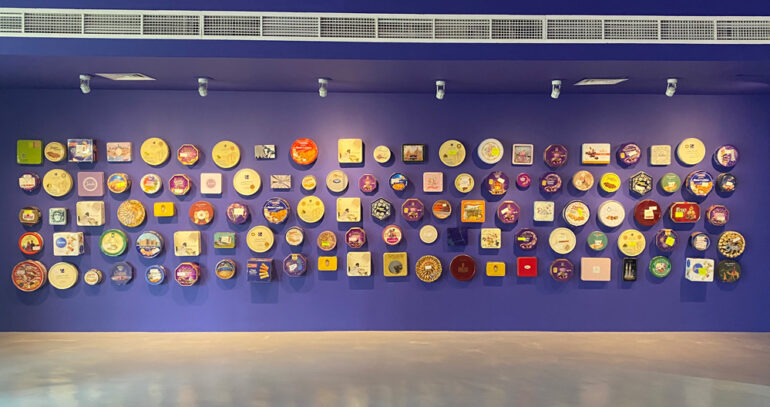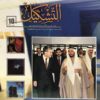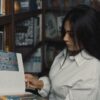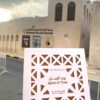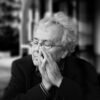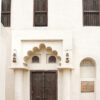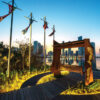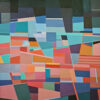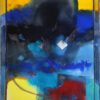What’s most interesting about Dr. Karima Al Shomely’s artistic experience is her insistence to hold on to her identity and seek her inspiration from the Emirati traditional heritage. she has laid one condition for herself, since the beginning, which is to add and rephrase the heritage in a new feel to keep up with contemporary art updates.
The perception of modernism and post-modernism differs based on cultural, social, and ecological considerations in first place rather than factors of kind and specifications. modernism dictates leaving the consideration of the inherited system behind, or building on them while keeping an eye on the things to come, meaning to combine the modern efforts with the heritage in an attempt to construct a new vision and special concepts. This relation between the artist’s connection to his cultural heritage and his ability to fully absorb the concepts of modernism and post-modernism in a more comprehensive and open angle is closely related to how much he’s in contact with other cultures and civilizations and his knowledge of them, while also studying all the intellectual and artistic movements and trends created by modernism and post-modernism arts in an attempt to keep up with the global artistic movement.

This is what Karima Al Shomely sought, which led to her expanded realization of modern aesthetic concepts of art, and it enabled her to form her own vision. Karima relies in her artworks on starting a dialogue with the receiver, either directly where she is the main component, we find that in a performance act of her own or through a video or an interactive artwork, where she, for instance, invites the viewer to draw on her face. or, in some other times, where she seeks to introduce artworks that contain symbols and vague suggestions to create some kind of puzzle, mystery, or thrill, she invites the viewers to start a dialogue, decode the symbols, and seek the indirect concept which is often deeper and more effective for them(1)
Karima states: “My artworks try to touch the inhumane aspects and the changes that storm over human beings, those could political, economic, or social changes. the human being is the center of the society, he’s the maker, and the main cause to effect those changes; positive were they or negative.”(2)
Heritage and Contemporariness

Karima Al-Shomely adapts contemporary aesthetics and styles while executing her artworks, such as installation, assembling, and conceptual art. she found in herself, as an artist, the ability to embody all that crosses her mind and imagination. for her, the concept of the artwork is the foundation, then comes the style, technique, and execution methods.
On the premise that the genuine deep-rooted cultural heritage cannot be easily replaced, Karima finds herself in the middle of a process trying to mix and combine the traditional heritage with new art trends, hence enveloping her artworks with a theme of reviving heritage, or inspiring heritage to introduce it in a contemporary way. her artworks are like a mirror that reflects her reality, a reality that witnessed shifts and sudden transformation in society, so her artworks contain symbols inspired by the cultural heritage and civilized reservoir, along with the traditional art inheritance and the social reality of the UAE.
Emirati Burqa
In 2018, Karima had her exhibition “Emirati Burqa” at Sharjah Heritage Museum, in which she introduced various visual patterns and artistic styles; photographs, and paintings, in addition to fabrics and materials of which burqa is made, and the various ways of wearing it. Karima states that the importance of the exhibition lies in it being an attempt to document the history of burqa, before it was reverted to vanish amidst the social and cultural changes in the UAE.
Karima Al Shomely has been known to introduce artworks that reflect a contemporary optical vision of the Emirati burqa as an important component of many heritage components of the UAE. the burqa in itself was a source of inspiration for many artists, it even constituted, to some of them, a main theme and subject for their artworks.
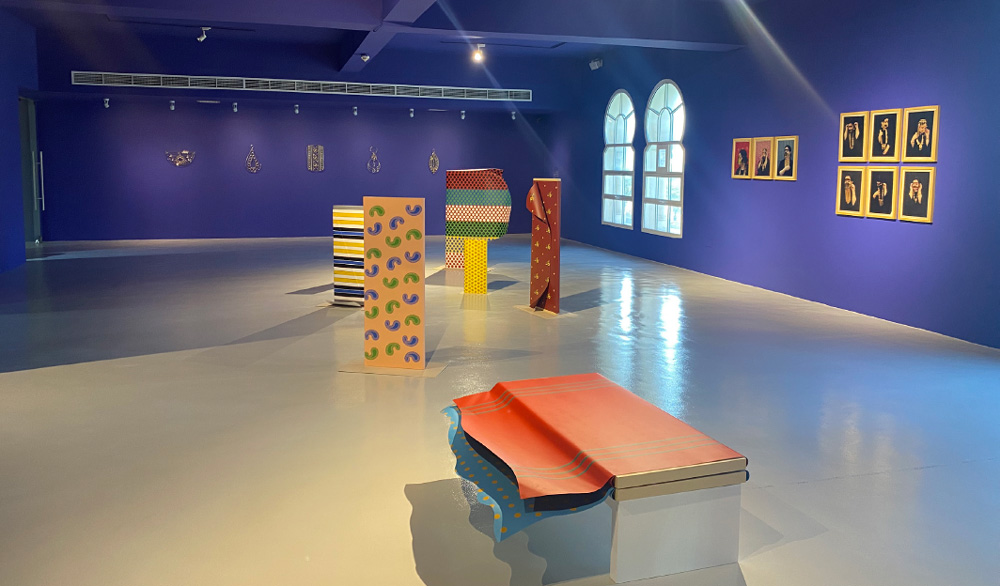
Karima says that wearing a burqa was the result of a traditional social ritual, it was not a religious one but rather a traditional culture. a burqa is considered a part of the traditional daily wear for Emirati women, and it expresses their social and aesthetical identity. but its usage is now rare and almost solely worn by women of old age, and in official occasions and celebrations, and that is due to the social and cultural changes and transformations in Emirati society. Karima Al Shomely also describes how fascinated she was with the burqa her grandmother used to wear, as it is printed in her childhood memories. the purpose of the burqa back in the time was modesty and decency, in addition to protection against weather conditions. Burqa also has habits and rituals in the traditional Emirati culture, for example, the size of the burqa differs based on the age of the woman wearing it, and based on the region and the occasions, so that wedding burqa is quite unique and it is crafted with gold, and it is called “Al Raisi Burqa”.(3)

In her art piece “Some of their stories”, displayed in the 37th annual exhibition of Emirates Fine Arts Society at Sharjah Museum in 2021, Karima Al Shomely sheds the light on the experiences of some Emirati women with the burqa. she narrates to us some of their stories that reflect social rituals and traditions that were predominant at the time. she says “Mrs. Maryam who was forced to wear burqa on her wedding night in spite of her refusal and crying. also, Aysha who tore and ruined many burqas, refusing to wear them, until she was told that her husband will give her money when he takes off her burqa and sees her face for the first time. also, Mrs. Tarifa, who was trying to imitate her mother by wearing a burqa when she was little, and when she became 15, she wore it without knowing how to tie it…”(4)
“Sahhara: Hidden Adornments”
Her current exhibition “Sahhara: Hidden Adornments” at Maraya Art Center, Curated by Cima Azzam, is a continuity for her theoretical, artistic, and applied research about the burqa, she reverts us to the element of “Sahhara”, which is a wooden box often adorned, and women use it in some cultures to store and collect clothes and jewelry and other personal items. Karima Al Shomely, speaking about her exhibition, says: “This exhibition celebrates women as integral cultural icons to the public, and sheds the light on their importance as individuals, and explores their personal experiences conveyed in her style of clothes, accessories, and cultural habits. the exhibition dedicates special importance to women’s inner adornments, and reflects the memories from a contemporary perspective via the artworks that stir all the nostalgic feelings to the past when women used to wear adornments that reflect their inner beauty.”
It is worth mentioning that artist Karima Al Shomely (born in Sharjah) has a Ph.D. from Kingston University in the UK, and her thesis was titled “The Emirati Burqa from a Cultural artistic angle”. Karima Al Shomely has accomplished, during her studies, a full archive of burqa for the different types of burqa and the materials such as fabrics and others that were used to craft it. she drew and described the types of burqa and its definition, and shed the light on its different kinds, which differ from one emirate to another. this archive is considered a valuable reference for researchers about the folklore and Emirati heritage. The importance of Karima’s study about burqa lies in its ability to deploy all of its vocabularies and human and social dimensions, and converting into an artwork centering around creativity and renewal.

References
1. “Memory & Art: The Artistic Movement in the UAE From the Early Foundation to Contemporary Times” by Researcher and Dr. Nuha Farran.
2. Karima Al-Shomely: “invisible”, “Masks” catalogue, Sharjah 2012.
3. “Memory & Art: The Artistic Movement in the UAE From the Early Foundation to Contemporary Times” by Researcher and Dr. Nuha Farran.
4. Karima Al Shomely: “Some of Their Stories”, the 37th Annual exhibition cataloguq by Emirates Fine Arts Society, Sharjah Museum, 2021
Dr. Noha Farran is the Founder & CEO of ‘Thinking Art’ Foundation’, Historian, Professor, Cultural Strategist, Researcher, Curator, Visual Artist & Chief Editor of Al Tashkeel magazine. Holding a Ph.D. with excellence in the 'Art & Science of Arts', an MFA in Fine Arts, and an MA in the philosophy of art, she has authored numerous published books and research papers documenting art in the Arab World.

